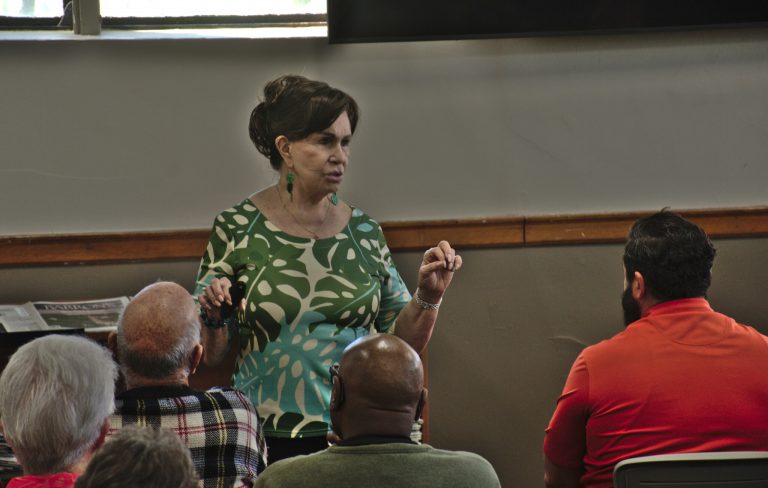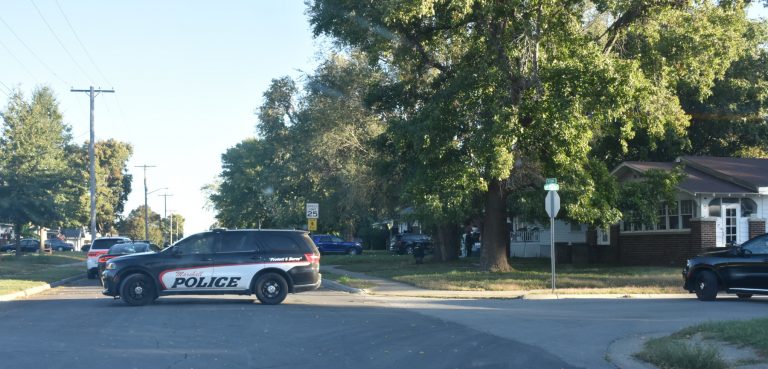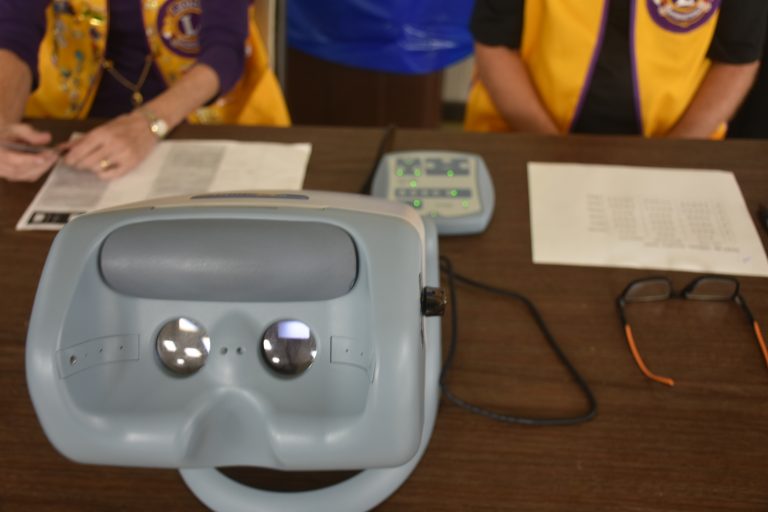By Sarah Gray/Managing Editor
“December 7th could never happen, just like 9/11 could never happen.”
Dorinda Makanaonalani Nicholson stood in front of a packed room at Missouri Valley College’s Murrell Library Monday, April 21. An intricate yellow flower tucked into her hair, a smile glowing as she joked with those in attendance.
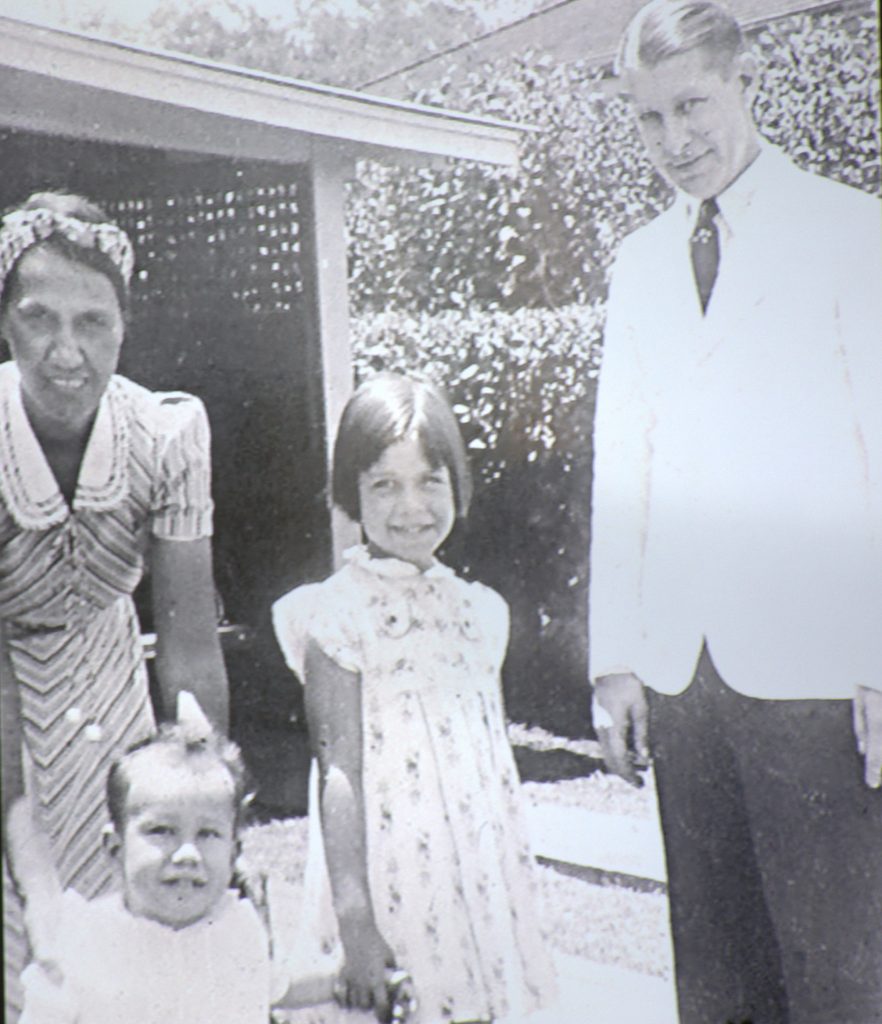
Dorinda stood in front of screens, clicking through images of her childhood in Hawaii. It was a story of a beautiful hula dancer and a soldier boy from Missouri, she said of her parents. Her childhood was filled with happiness, until one Sunday morning when it would be shaped by the devastating attack from above.
Dorinda presented her eye-witness account of the attack on Pearl Harbor, which drew the U.S. into the Second World War. Until that day, the U.S. had aided Europe by sending supplies and food.
“Hawaii is the most isolated land mass,” she said. “Thousands of miles in the middle of the Pacific Ocean. … America is watching Japan take over other countries … Germany had invaded Poland. The war had started. … Did you know December 7, 1941, can’t happen? So, we’re watching Japan – 4,000 miles. Their planes – it’s not like our air bases. We didn’t have B-2 bombers. We had airplanes with one propeller. ‘They’re not going to come 4,000 miles. We are fine. We are safe.’”
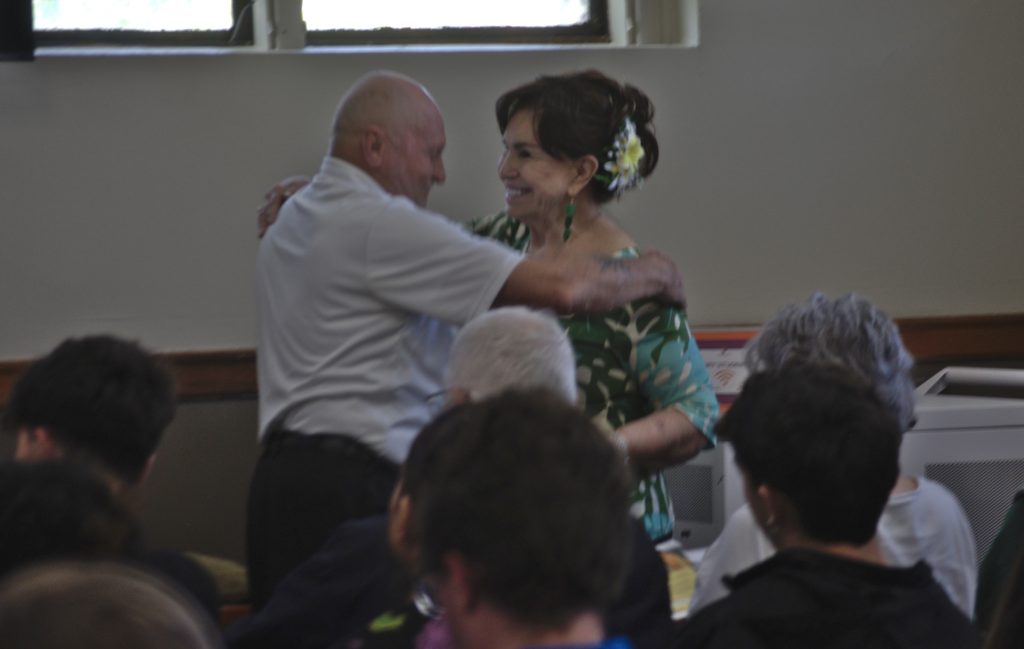
She stated that around Thanksgiving of that year, there would have been six submarines leaving the northernmost islands of Japan.
“They chose December for a reason. (They) want the weather to be awful,” she said. “They take off. No messaging back and forth. Three-hundred-and-some airplanes … on the aircraft carriers you do a papoose to hold midget submarines, two men, so when they bomb Pearl Harbor, you have the suicide submarines to ram the ships.”
Japan had by far more aircraft carriers. There were two at Pearl Harbor, and one was in dry dock.
“We were civilians in the middle of Pearl Harbor at this time,” she continued.
Dorinda is one of few Americans in our lifetimes that has experienced a bombing or an attack as a child. Now living in the Kansas City area, she has spent years returning to Pearl Harbor, writing and speaking about her experiences.
“… if you lived in England, you would have gone down to what would be underground to sleep at night, and your baby brother would be born down there,” she noted. “’Blockbuster’ is not an out-of-business video store. That was the bombs that would come into England from Germany, and they would take out a block. So – children – this was a time of suffering for everyone.”
On the screen behind her, she showed photos of her family’s home, her parents and little brother, herself in a hula skirt.
She recalled the planes she and her father saw that Sunday morning.
“We had to be at Sunday School about 9 (o’clock), so Mom’s getting breakfast about 7:30, and we hear planes going … We always heard airplanes going over, but why would they be practicing on Sunday? That doesn’t seem right,” she recalled them thinking. “And then they got louder and louder, and our kitchen started to shake. My dad ran through the screen door area into the front yard, and I’m right after him, leaning up against him. And it’s early. … So Dad and I are standing there shielding our eyes, and just barely above our house are these low-flying airplanes. I now know they are torpedo bombers. They have to come in low. Canopies pushed open. I can see the goggles on these pilots.
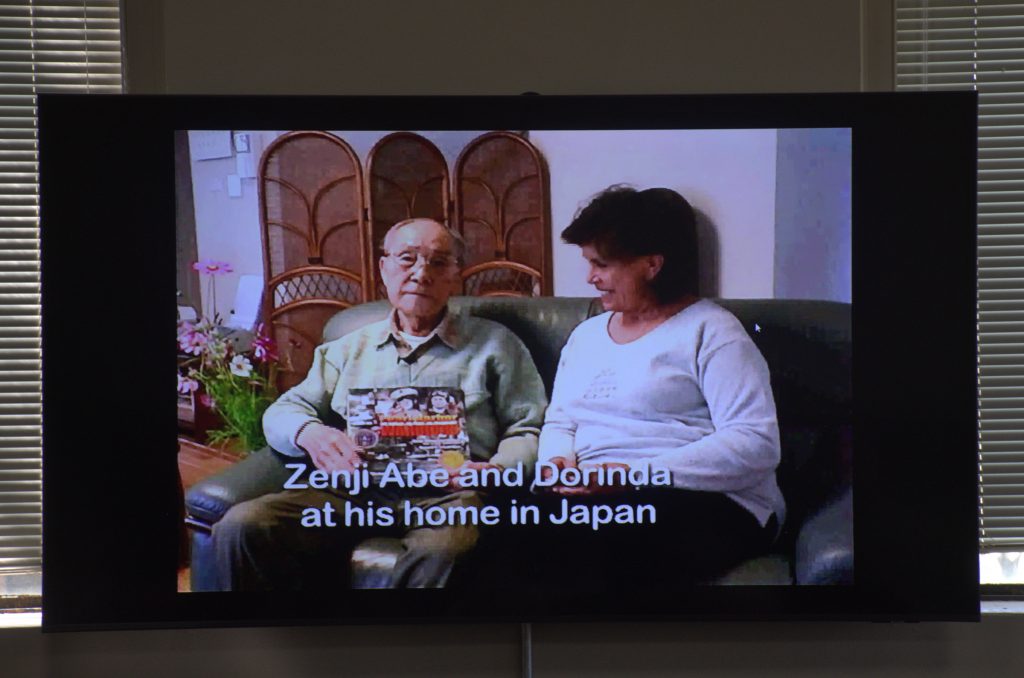
“My dad grabs me, runs into the house, baby brother out of the crib, Mom, and into the back of the car. And we try to get away to hide in the sugarcane fields.”
While in the sugarcane fields, the family heard updates on the car radio.
“The radio announcer says ‘This is the real McCoy. Military, get to your bases. Medical, nearest hospital to treat the wounded, the injured. The rest of you, stay in your house. No, do not use the phone.’ And then went off the air,” Dorinda recalled.
“We could look down on the harbor. And some of you are not old enough for 9/11, but I remember watching at work, 9/11 and how the towers just burned and burned and burned,” she told the crowd. “The Arizona burned and burned, and the ships in the harbor burned and burned.”
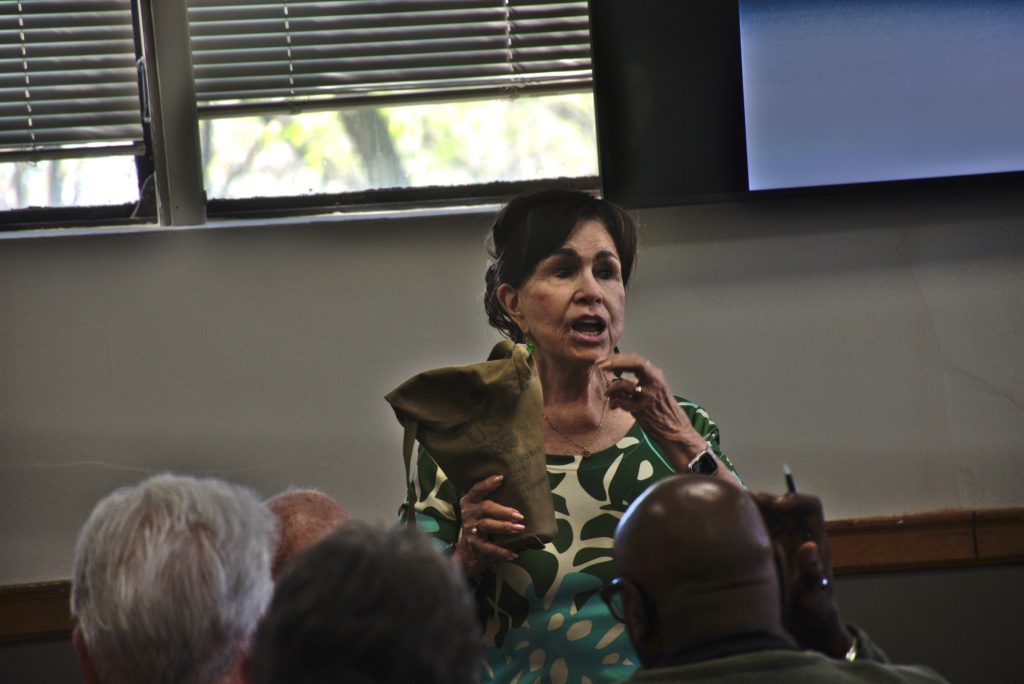
Hawaii’s governor would later come on the air, stating he had communicated with President Franklin Roosevelt. Dorinda remembered him saying he declared Martial Law – a rare occurrence which involves replacing civilian government with military authority temporarily.
“Martial Law means this – you may not leave your house after dark. You may not turn on lights in your house. You may not speak any language other than English on the telephone. Everyone 2 years and older will have a gas mask with them at all times,” Dorinda stated.
Eighty-three years later, Dorinda still has her child-sized gas mask.
She held it up for the audience, clicked through photos of herself and brother, school children practicing bomb drills with their teacher in the background – gas mask in hand.
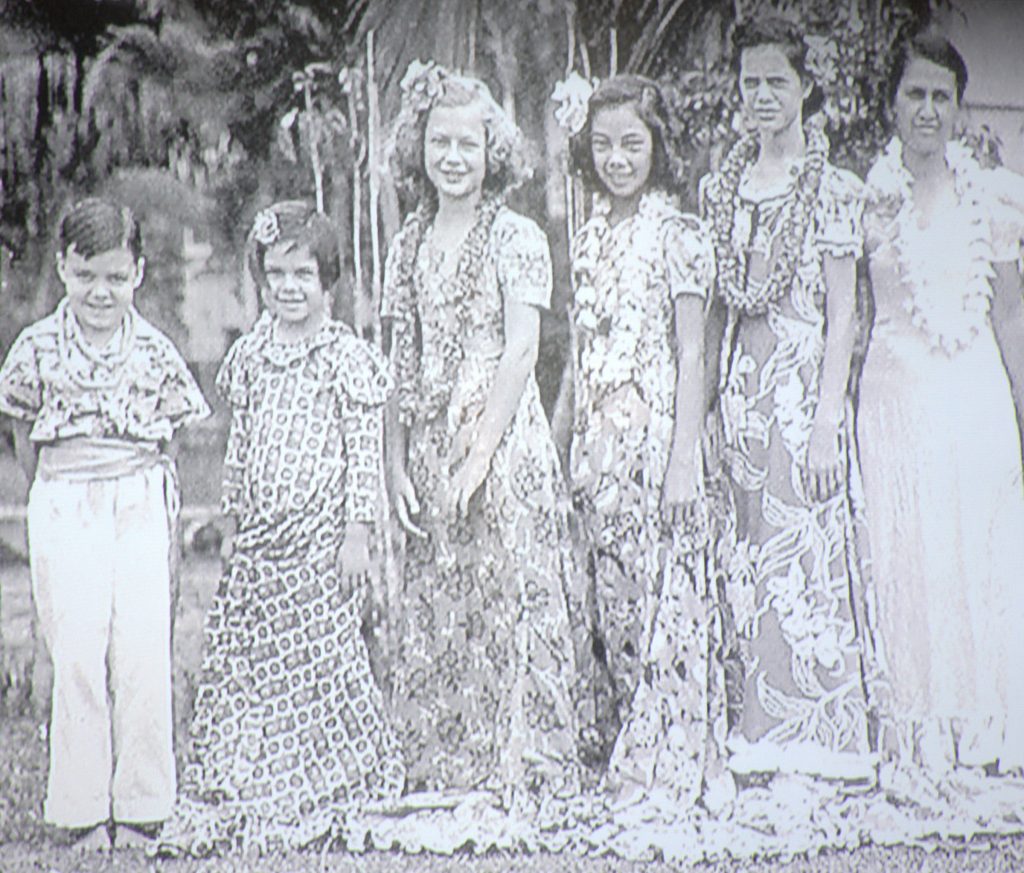
Times had changed on Oahu, as they had across the globe during World War II. Beaches were lined with barbed wire. The governor’s house had guards stacked in front of the entrance. Dorinda and many other children saw this regularly as they found ways to bring normalcy back into their lives.
She spoke of the couple-thousand Japanese residents of Hawaii who stood together at the capitol asking to serve in the U.S. military, the women who went to work, the troops who came from the mainland, and rationing. She also spoke of an unlikely friendship.
Years after the war, an American bugler named Richard Fisk, who ended up in the water while the USS West Virginia was sinking, and a Japanese pilot named Zenji Abe would meet.
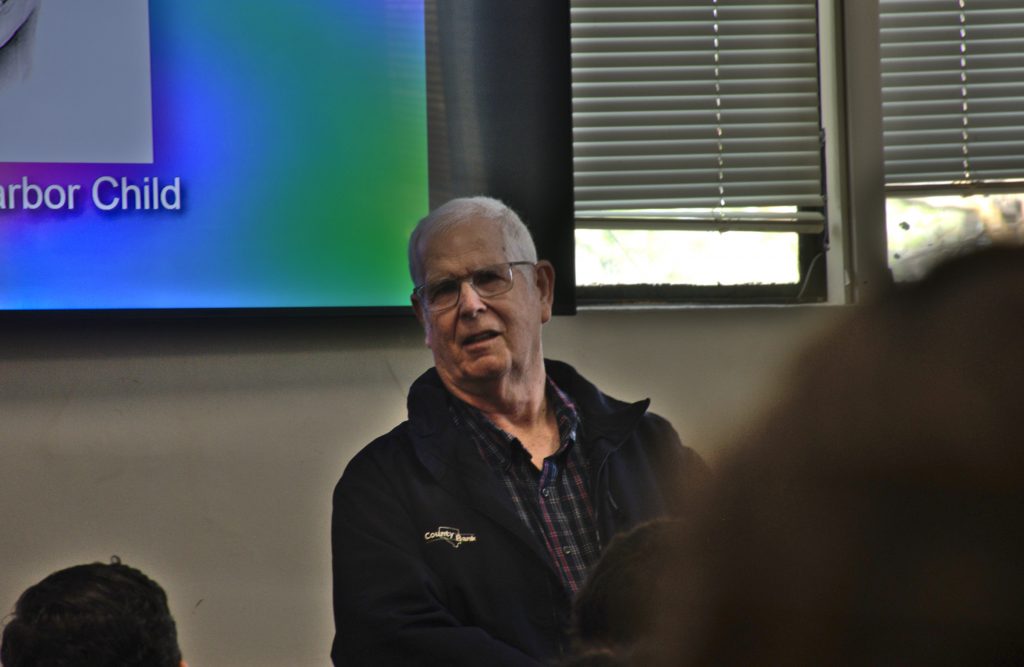
Ken noted that the Japanese wanted to sink that ship to block the use of the harbor, and it was hit several times by bombs and torpedoes. He stated the captain ran it up on Hospital Point so it wouldn’t sink. The ship would eventually be patched and refitted. “He said it looked like a porcupine,” Ken recalled of his father’s stories. “He served on that ship throughout the whole war.” (Sarah Gray/Democrat-News
“Because Richard is high up and the plane is low, sending the torpedoes, he sees the pilot’s face. And that’s when the hatred began for Richard,” Dorinda explained.
Richard Fisk spent years dealing with trauma that so badly wounded him emotionally that he continuously sought physical medical attention. Dorinda had an opportunity to meet him.
“Richard said ‘I hated the Japanese, but one morning when I woke up again in the recovery room, the doctor said ‘okay, Sarge, what’s really eating at you? I can’t cut anything else out of you.’ And Richard, (with his) white handlebar mustache says, ‘I was embarrassed to say I have nightmares. I was scared. I hate.’ But he wanted to live. So, from that point on, he tried to get in touch with some of these Japanese pilots.”
Fisk attended a monthly meeting for Pearl Harbor survivors and suggested they invite some of the Japanese pilots to their meetings. He put ads in newspapers overseas. One month, six pilots came, and Fisk made a significant bond with Zenji Abe.
“If you could have gone (to Pearl Harbor) 20-some years ago, you would have seen them (together) on the last Sunday of the month, two red roses tucked under one arm and his bugle in the other,” Dorinda described. “And Richard talking about how he can’t hate any more. These warriors made peace with each other.”
This September will mark the 80th anniversary of the end of WWII. The war involved more than 30 countries, and more than 50 million people lost their lives. On May 8, 1945, the war in Europe came to an end. Later, U.S. President Harry Truman announced Japan’s surrender, and on Sept. 2, 1945, formal surrender documents were signed aboard the USS Missouri.

The Pearl Harbor National Memorial honors the lives affected by the 1941 attack on Pearl Harbor. Visitors can view 1,177 names at the memorial, many of them sets of brothers, a photo of Dorinda and her brother with their gas masks, and oil continuing to tarnish the water from the sunken ship below.
It’s a history Dorinda will continue telling, particularly giving a voice to children who are affected by war, and a reminder that the atrocities of war are far reaching. Peace is possible. And friendships and healing can be born out of the soot.
Note: Dorinda Nicholson is a retired marriage/family therapist. Learn more about her and her story online at pearlharborchild.com. Her book, “Pearl Harbor Child: A Child’s View of Pearl Harbor – From Attack to Peace,” can be found on Amazon.

